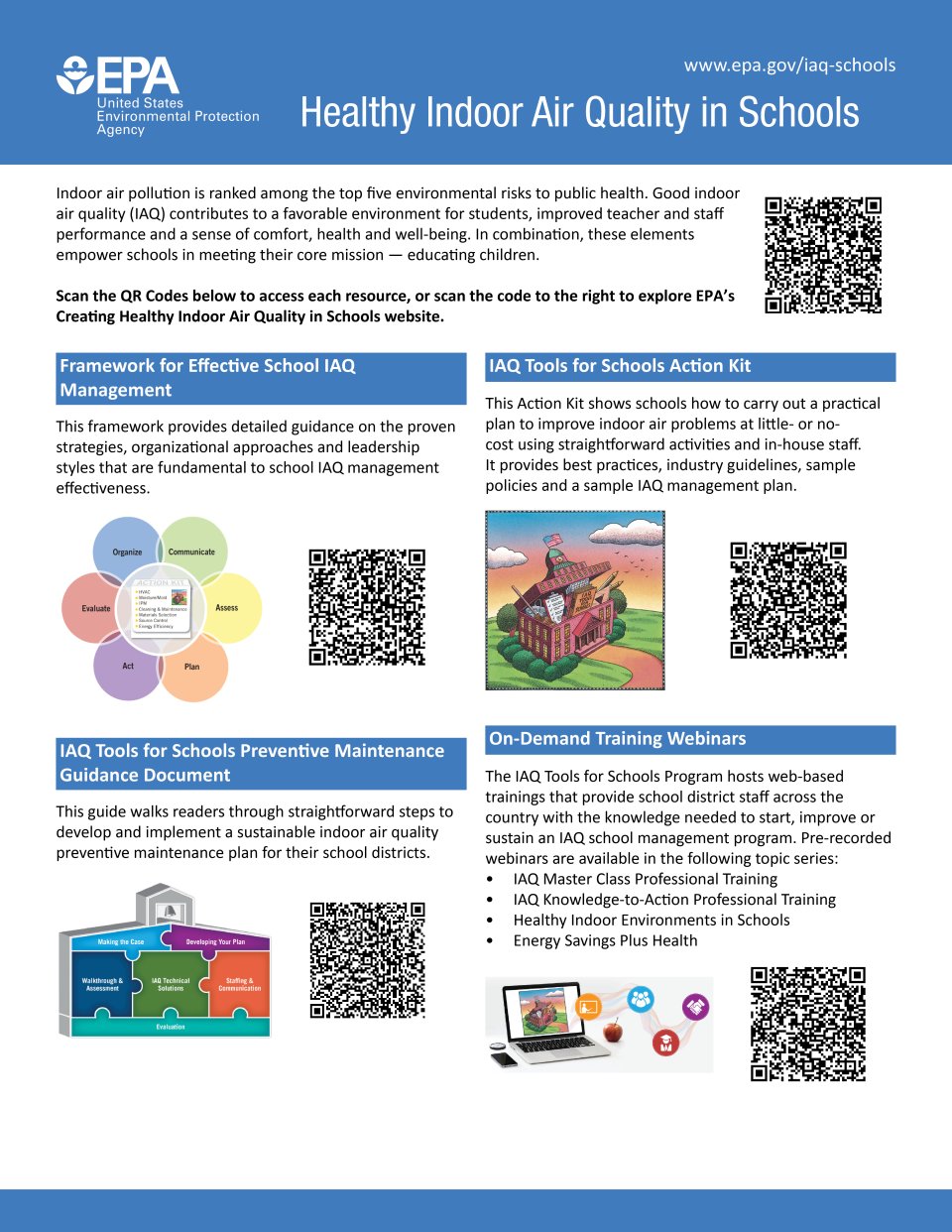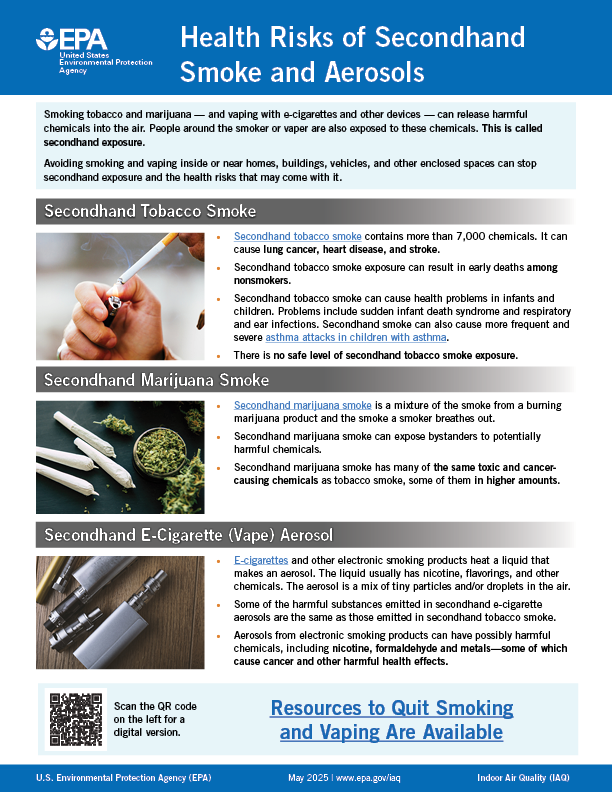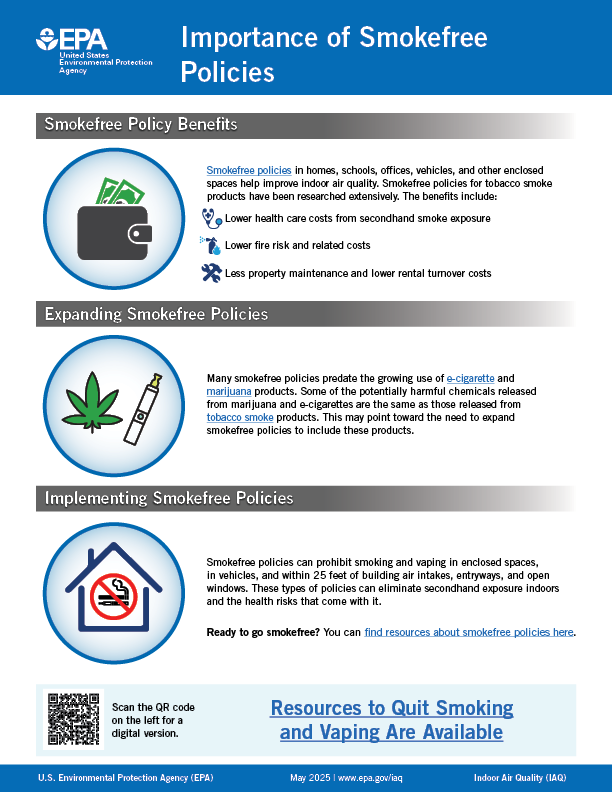Publications about Indoor Air Quality
On this page:
- For Kids
- Publications Resource One-Pagers
- Introductions & Guides
- Tribal Publications
- Infographics
- Fact Sheets
- Tools, Models & Studies
- Reports & Project Summaries
- Pollutant Specific Publications
- CPSC Publications
On other pages:
For Kids
Air Cleaning Allies
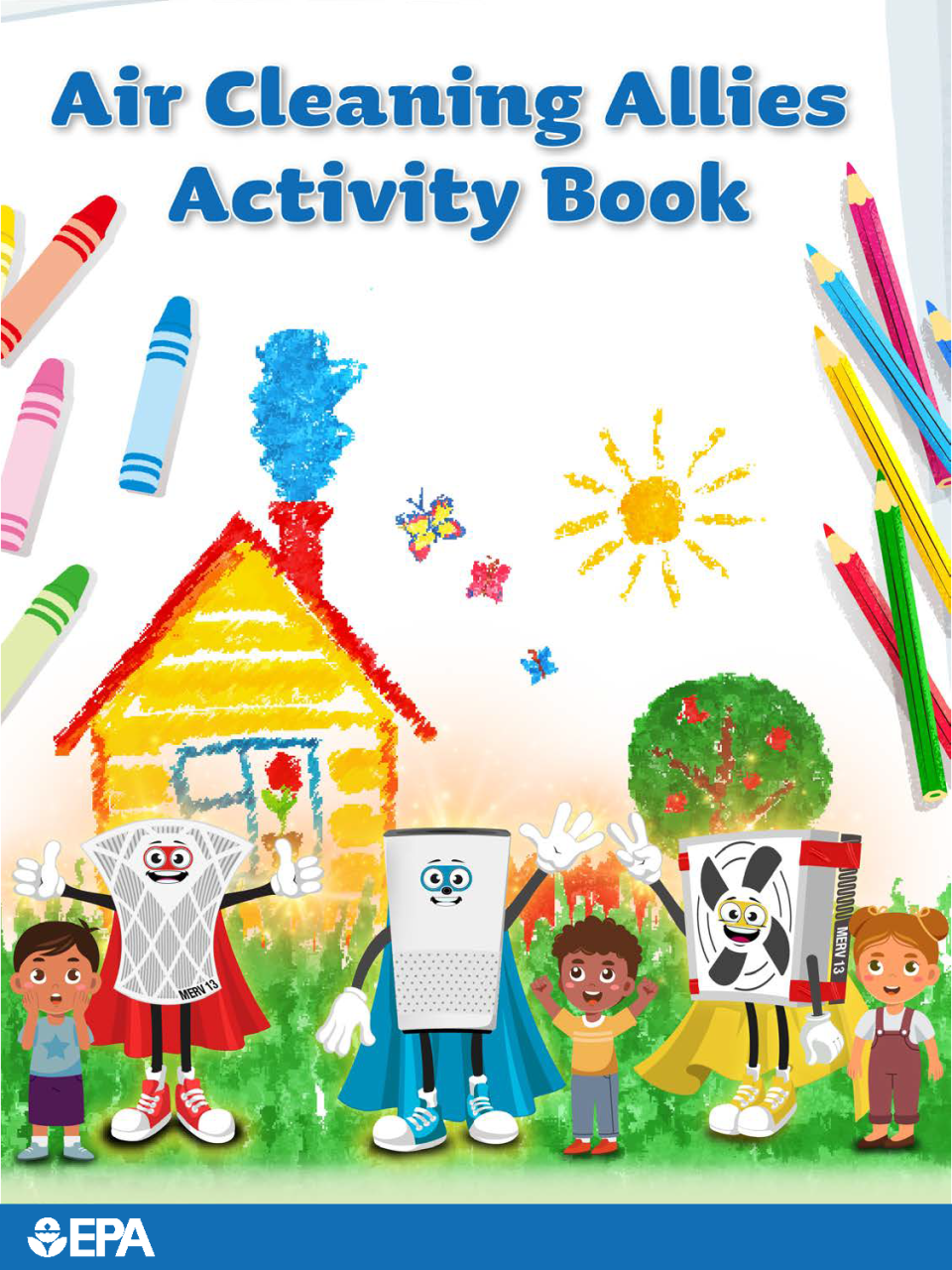
Meet the Air Cleaning Allies as they help a family learn about and deal with sources of indoor particle pollution. Follow along in the story and complete a series of activities to learn about filtration and air cleaning with Merv the air filter, Aerie the air cleaner, and DJ the do-it-yourself air cleaner.
Clean Air Superheroes Defeat Radon Activity Book

Join Mateo and his friends as they become superheroes in their community, learning about radon and how to defeat it in their homes. Follow along through fun, comic book-style illustrations and complete interactive activities, such as coloring pages, word searches and I Spy.
Publications Resource One-Pagers
Flood Publications Resource One Pager
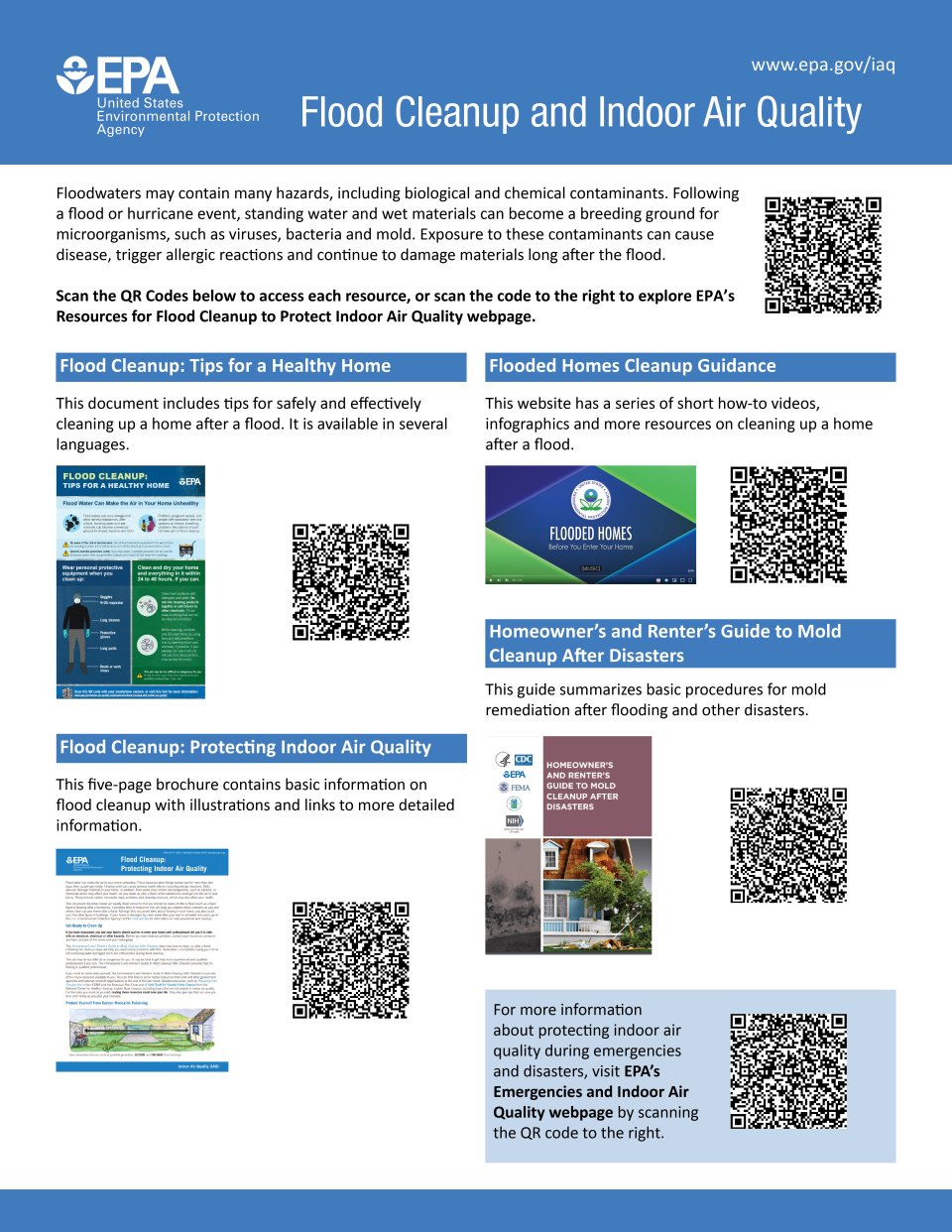
This one-pager has QR codes to several flood cleanup resources – including guidance for homeowners and renters to better understand how to safely and effectively cleanup after a flood. Emergency management and public health professionals can easily share these resources digitally. Simply scan the QR codes to access the resources.
Mold Publications Resource One Pager
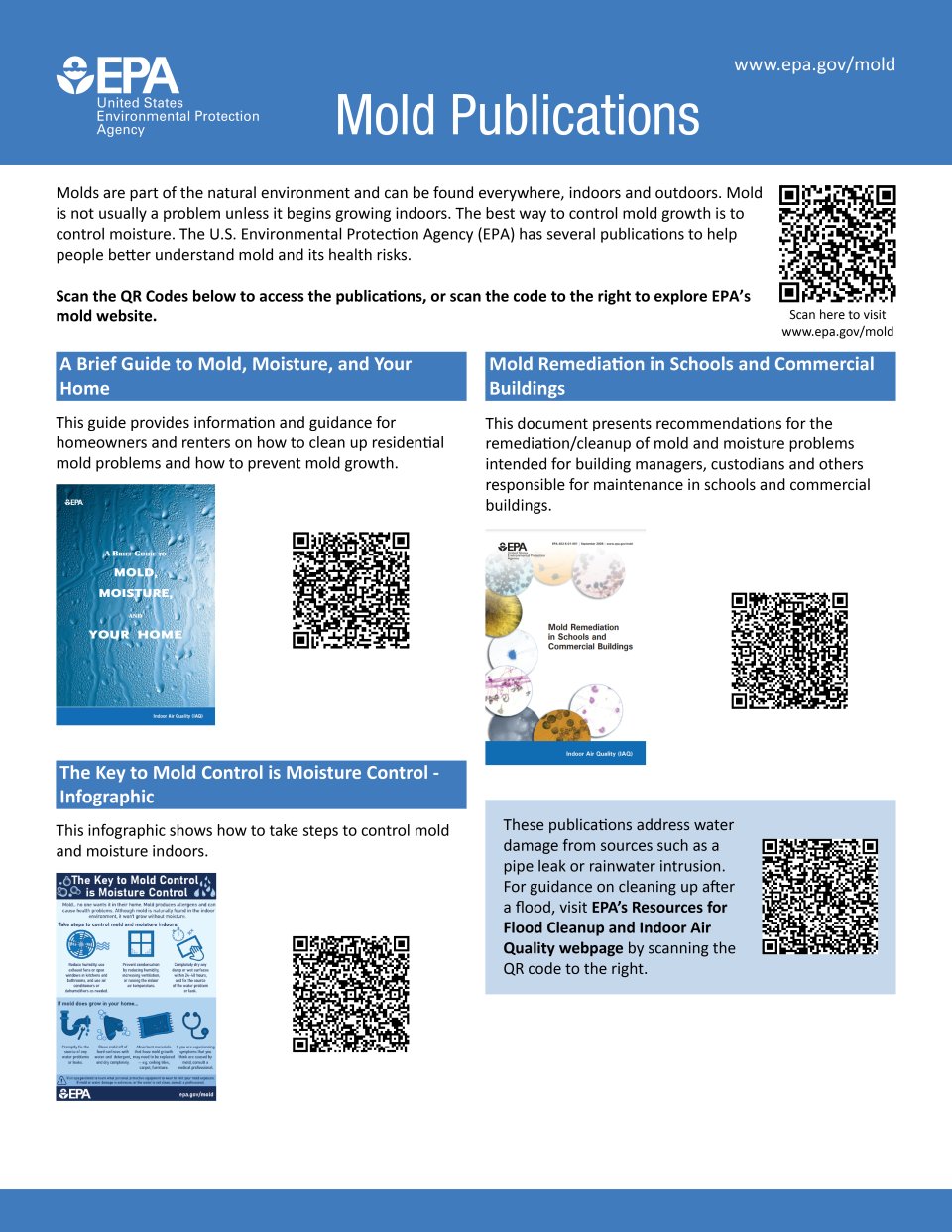
This one-pager has QR codes to several mold cleanup and moisture control resources – including guidance for homeowners and renters to better understand how to safely and effectively cleanup mold and control moisture. Emergency management and public health professionals can easily share these resources digitally. Simply scan the QR codes to access the resources.
Radon Publications Resource One Pager
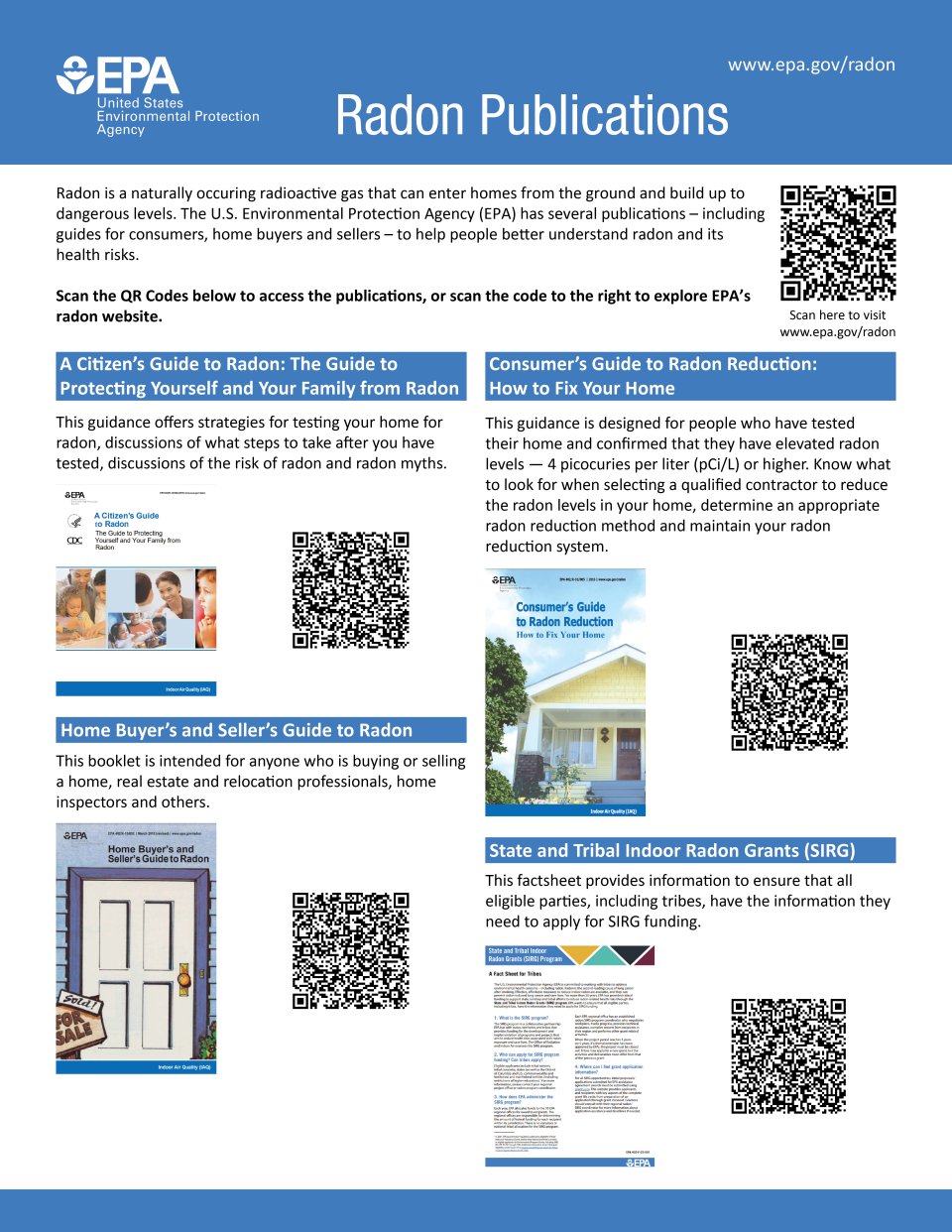
This one-pager has QR codes to several radon publications – including guides for consumers, home buyers and sellers – to help people better understand radon and its health risks. Professionals in the real estate industry or public health can easily share these publications digitally. Clients can simply scan the QR codes to access the publications.
Healthy IAQ in Schools Publications Resource One-Pager
This one-pager has QR codes to several IAQ in Schools resources – including guides for parents, teachers, school administrators, and school maintenance professionals. Learn how good indoor air quality (IAQ) contributes to a favorable environment for students, improved teacher and staff performance and a sense of comfort, health and well-being. In combination, these elements empower schools in meeting their core mission — educating children. Simply scan the QR codes to access the resources.
Asthma Publications Resource One-Pager
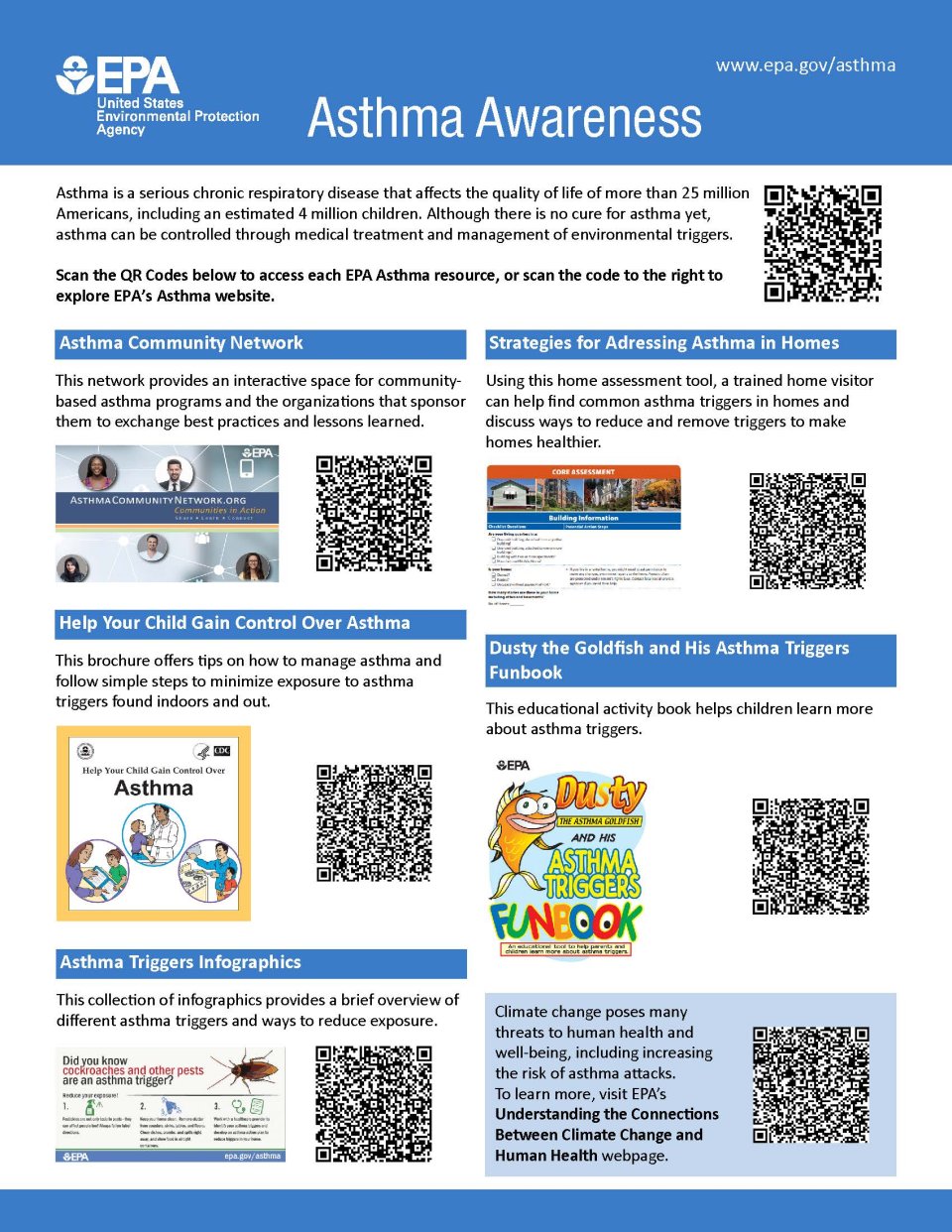
This one-pager has QR codes to several asthma resources – including guides for asthma triggers, tips for controlling asthma and a home visit checklist for healthcare professionals. Learn how good indoor air quality contributes to a favorable environment for individuals with asthma. Simply scan the QR codes to access the resources.
Wildfires Resources One-Pager
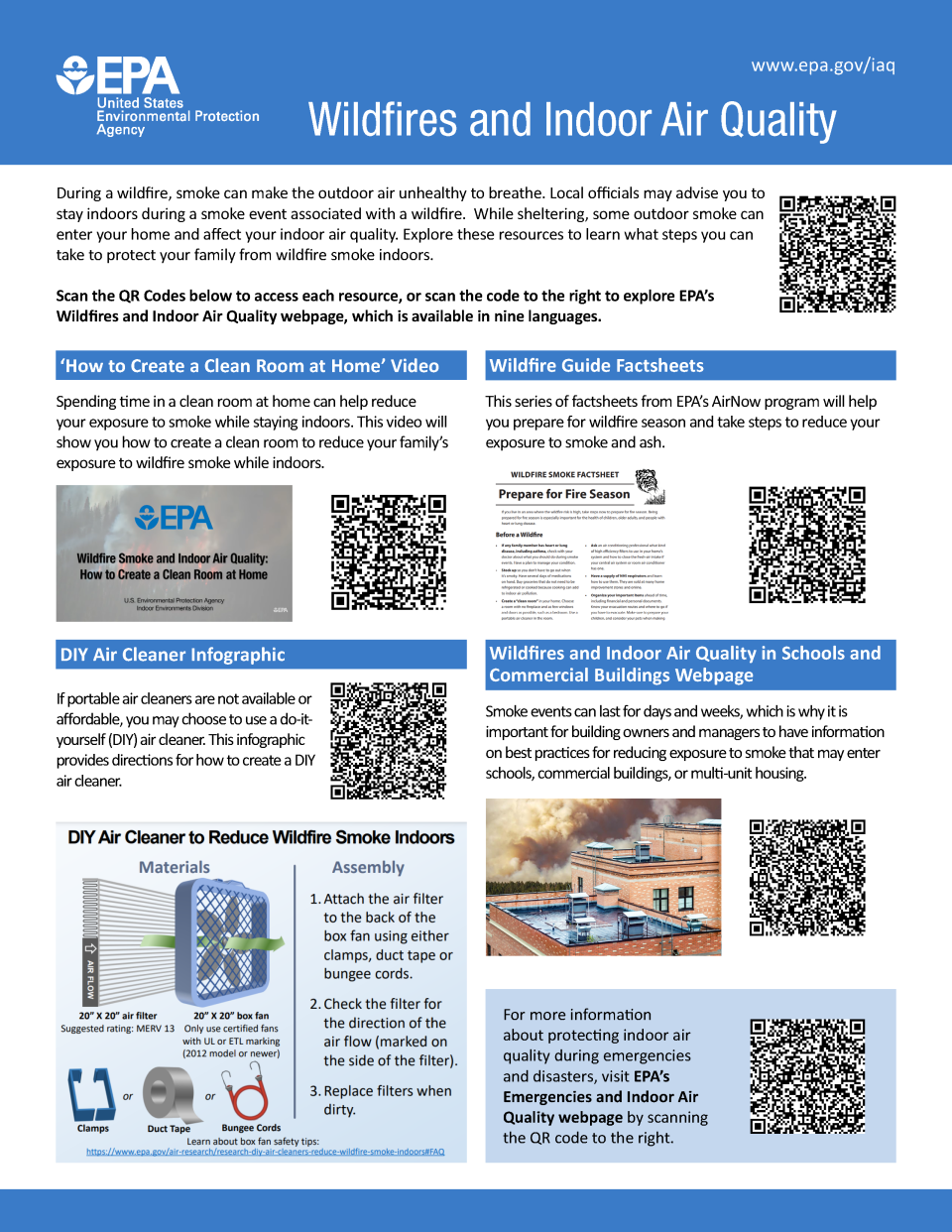
This one-pager has QR codes to several Wildfire and Indoor Air Quality resources – including guidance for making a DIY air cleaner, how to create a clean room in your home, and guidance for schools and commercial buildings during wildfire smoke events. Simply scan the QR codes to access the resources.
Power Outages Resources One-Pager
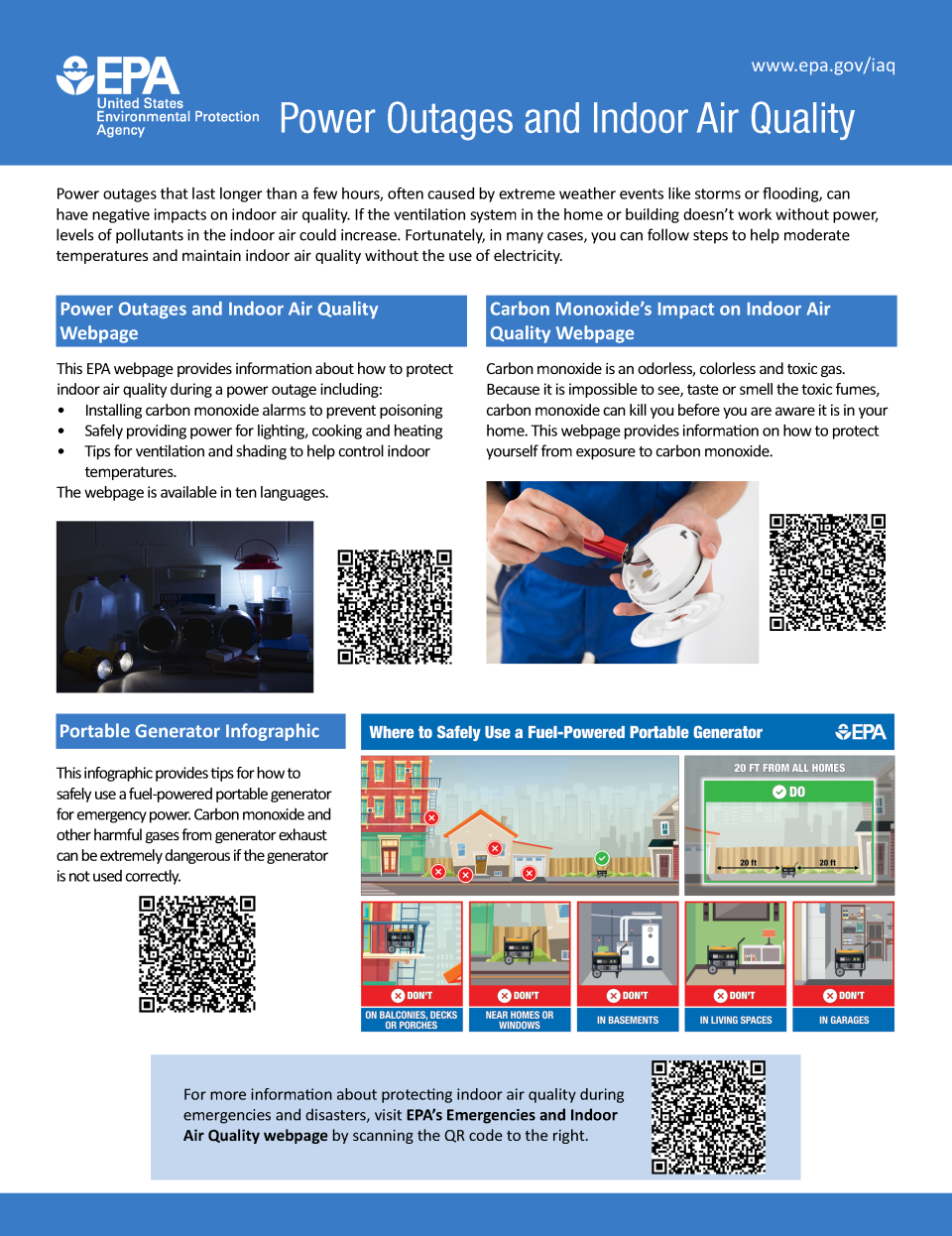
This one-pager has QR codes to several Power Outages and Indoor Air Quality resources – including information on safely using a fuel-powered portable generators, ventilation, carbon monoxide detectors and more. Simply scan the QR codes to access the resources.
Introductions and Guides
The Inside Story: A Guide to Indoor Air Quality
This is our most popular and comprehensive publication on the subject of Indoor Air Quality. While dated, it is still relevant as it describes sources of air pollution in the home and office, corrective strategies, and specific measures for reducing pollutant levels.
This illustrated booklet covers all major sources of pollution such as:
- radon
- household chemicals
- biological contaminants
- carbon monoxide
- formaldehyde
- pesticides
- asbestos
- lead
Includes a glossary and a list of sources for additional information. Written in easy-to-understand language for the general consumer. Coauthored by EPA and the Consumer Product Safety Commission.
- The Inside Story: A Guide to Indoor Air Quality is only available in HTML
Care for Your Air: A Guide to Indoor Air Quality

This brochure provides quick and simple overview of some key indoor air pollutants including radon, secondhand smoke, asthma triggers, volatile organic compounds, molds and combustion pollutants. The brochure unfolds into a poster that features action steps to improving indoor air.
- Care for Your Air (HTML version)
- Care For Your Air: A Guide to Indoor Air Quality (pdf)
- EPA 404/F-08/008, September 2008 [Only Available Digitally]
An Office Building Occupant's Guide to Indoor Air Quality

This booklet is intended to help people who work in office buildings learn about the factors that contribute to indoor air quality and comfort problems and the roles of building managers and occupants in maintaining a good indoor environment. Because good indoor air quality depends on the actions of everyone in the building, a partnership between building management and occupants is the best way to maintain a healthy and productive work space.
Residential Air Cleaners (Third Edition) A Summary of Available Information

This longer technical guide focuses on air cleaners for residential use; it does not address air cleaners used in large or commercial structures such as office buildings, schools, large apartment buildings, or public buildings. In addition to providing general information about the types of pollutants affected by air cleaners, this document discusses the types of air-cleaning devices and technologies available, metrics that can be used to compare air-cleaning devices, the effectiveness of air-cleaning devices in removing indoor air pollutants, and information from intervention studies on the effects that air cleaners can have on health and on health markers.
Guide to Air Cleaners in the Home (Second Edition)
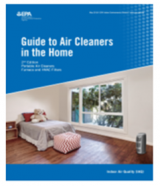
This short consumer guide covers portable air cleaners and furnace or HVAC filters used in a home. It includes tips for selecting a portable air cleaner, furnace filter, or HVAC filter.
Should You Have the Air Ducts In Your Home Cleaned?

This publication is intended to help consumers answer this often confusing question. The guide explains what air duct cleaning is, provides guidance to help consumers decide whether to have the service performed in their home, and provides helpful information for choosing a duct cleaner, determining if duct cleaning was done properly, and how to prevent contamination of air ducts.
Building Air Quality: A Guide for Building Owners and Facility Managers

The Building Air Quality, developed by the EPA and the National Institute for Occupational Safety and Health, provides practical suggestions on preventing, identifying and resolving indoor air quality (IAQ) problems in public and commercial buildings. This guidance provides information on factors affecting indoor air quality; describes how to develop an IAQ profile of building conditions and create an IAQ management plan; describes investigative strategies to identify causes of IAQ problems; and provides criteria for assessing alternative mitigation strategies, determining whether a problem has been resolved, and deciding whether to consult outside technical specialists. Other topics included in the guide are key problem causing factors; air quality sampling; heating, ventilation and air conditioning systems; moisture problems; and additional sources of information.
- The text of Building Air Quality is available here as a series of PDF files which you can download and view or print. You can go to the table of contents and select just the form or section that you need to download and view/print, or you can download the entire PDF version of the guide as a ZIPPED file to view/print.
- Building Air Quality Table of Contents and select the specific PDF file that you require.
Building Air Quality Action Plan
The Building Air Quality Action Plan (BAQ Action Plan) meets the needs of building owners and managers who want an easy-to-understand path for taking their building from current conditions and practices to the successful institutionalization of good IAQ management practices. It emphasizes changing how you operate and maintain your building, not increasing the amount of work or cost of maintaining your building. The BAQ Action Plan follows 8 logical steps and includes a 100-item Checklist that is designed to help verify implementation of the Action Plan.
Healthy Buildings, Healthy People: A Vision for the 21st Century

The Healthy Buildings, Healthy People: A Vision for the 21st Century, addresses the future of indoor environmental quality. In preparing Healthy Buildings, Healthy People, EPA sought the advice of many, both within the Agency and outside, to develop the vision, goals, guiding principles and potential actions presented in the report. Healthy Buildings, Healthy People lays out a blueprint by which agencies and individuals across the country, and around the world, can focus their efforts towards improvements in the indoor environment and health.
Indoor Air Pollution: An Introduction for Health Professionals

Assists health professionals (especially the primary care physician) in diagnosis of patient symptoms that could be related to an indoor air pollution problem. Addresses the health problems that may be caused by contaminants encountered daily in the home and office. Organized according to pollutant or pollutant groups such as environmental tobacco smoke, VOCs, biological pollutants and sick building syndrome, this booklet lists key signs and symptoms from exposure to these pollutants, provides a diagnostic checklist and quick reference summary, and includes suggestions for remedial action. Also includes references for information contained in each section. Co-sponsored by: The American Lung Association (ALA), The Environmental Protection Agency (EPA), The Consumer Product Safety Commission (CPSC), and The American Medical Association (AMA) U.S. Government Printing Office Publication No. 1994-523-217/81322, 1994
Tribal Publications
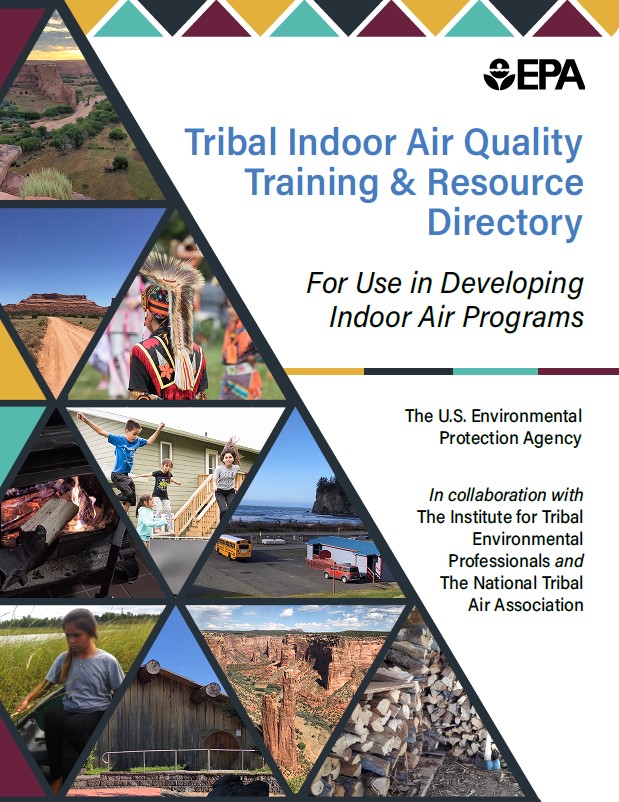
Tribal Indoor Air Quality Training & Resource Directory (pdf)
For Use in Developing Indoor Air Programs
This directory was created to consolidate helpful resources for tribes who are interested in starting or expanding indoor air quality (IAQ) programs in their communities. Look for the mouse icon next to all the clickable links in this resource to learn more about each topic and explore resources that aid in the development of IAQ programs.
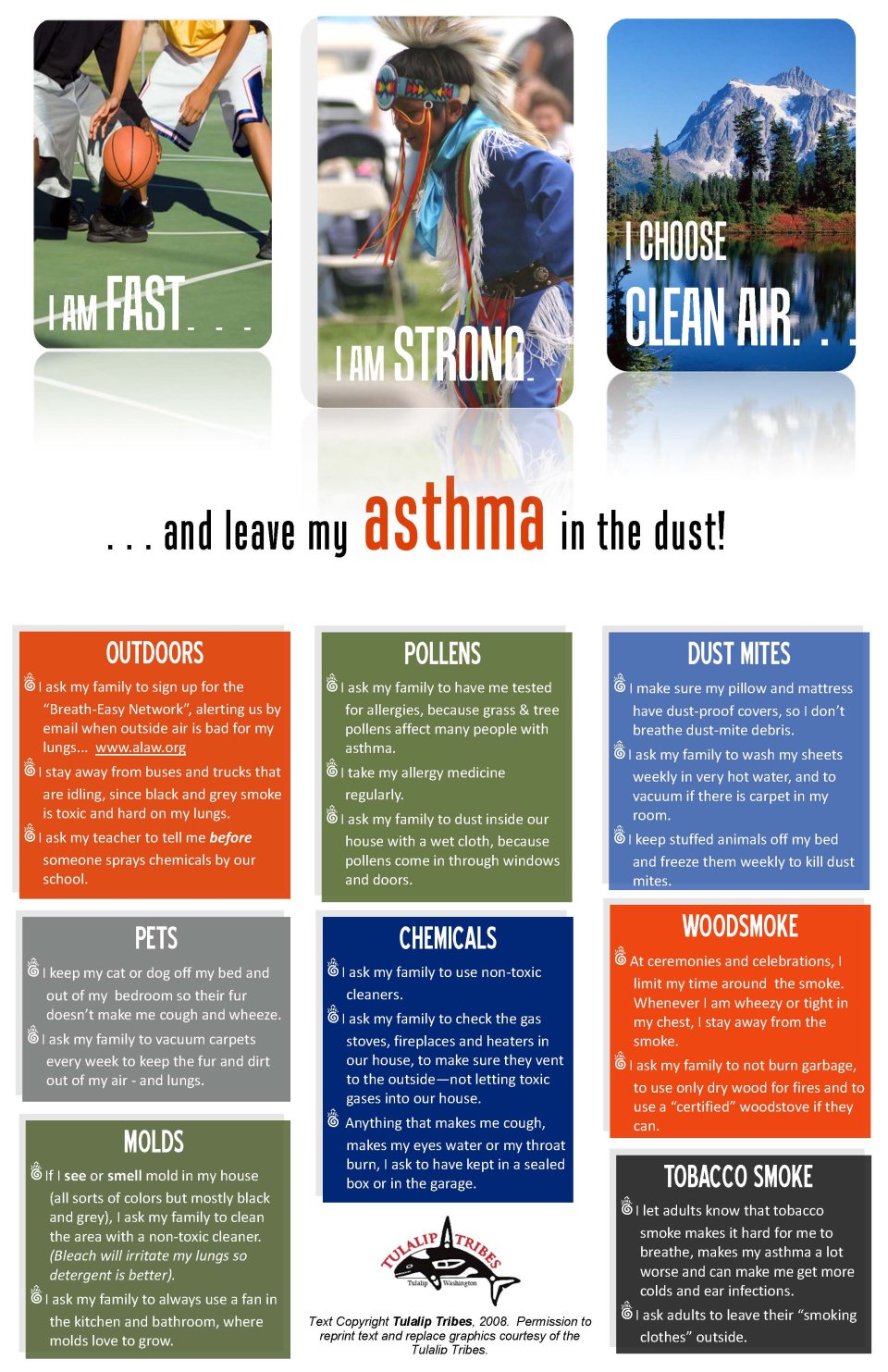
Leave my Asthma in the Dust! Youth Poster (pdf)
Information poster for Tribal Programs with tips about asthma.
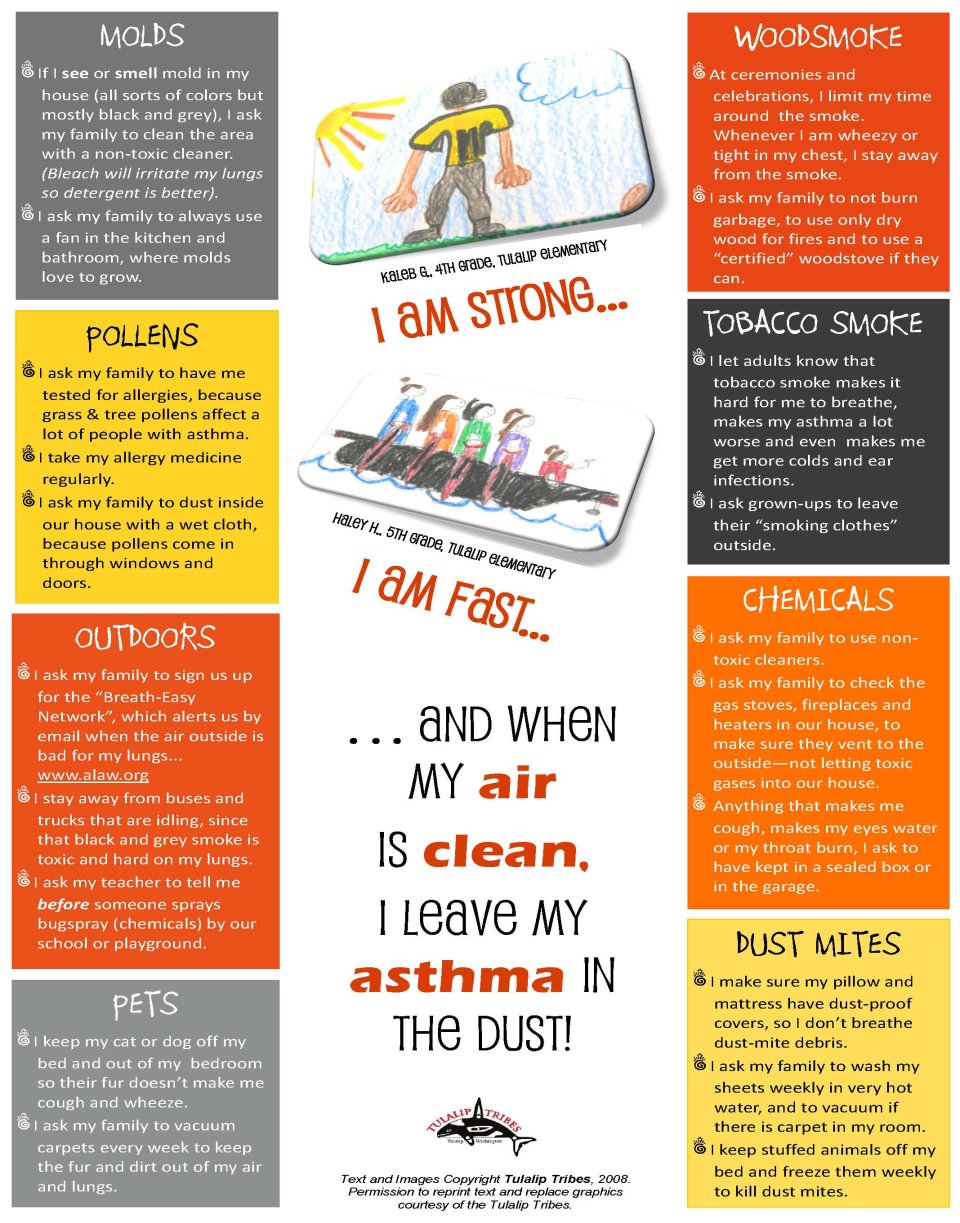
I Am Strong...I Am Fast Poster (pdf)
Information poster for Tribal Programs with tips about asthma.
Indoor Air Quality - Infographics
- Where to Safely Use a Fuel-Powered Portable Generator
- Improving Your Indoor Environment
- Flood Cleanup Infographic
- The Air Cleaning Allies
- Create A Clean Room During a Wildfire
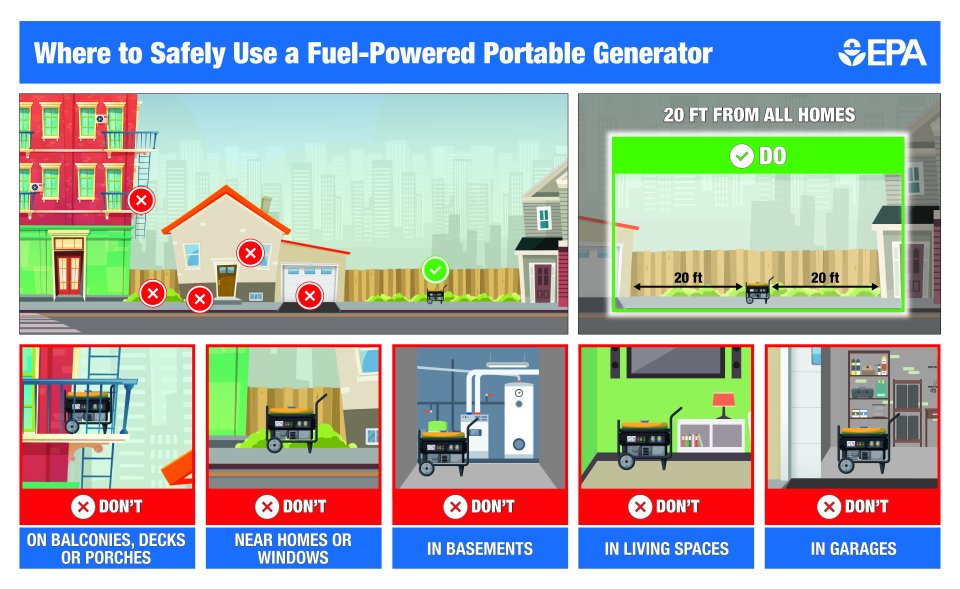
Where to Safely Use a Fuel-Powered Portable Generator Infographic (pdf)
This downloadable and printable PDF will show you where to safely place and use a fuel-powered portable generator outside your home.
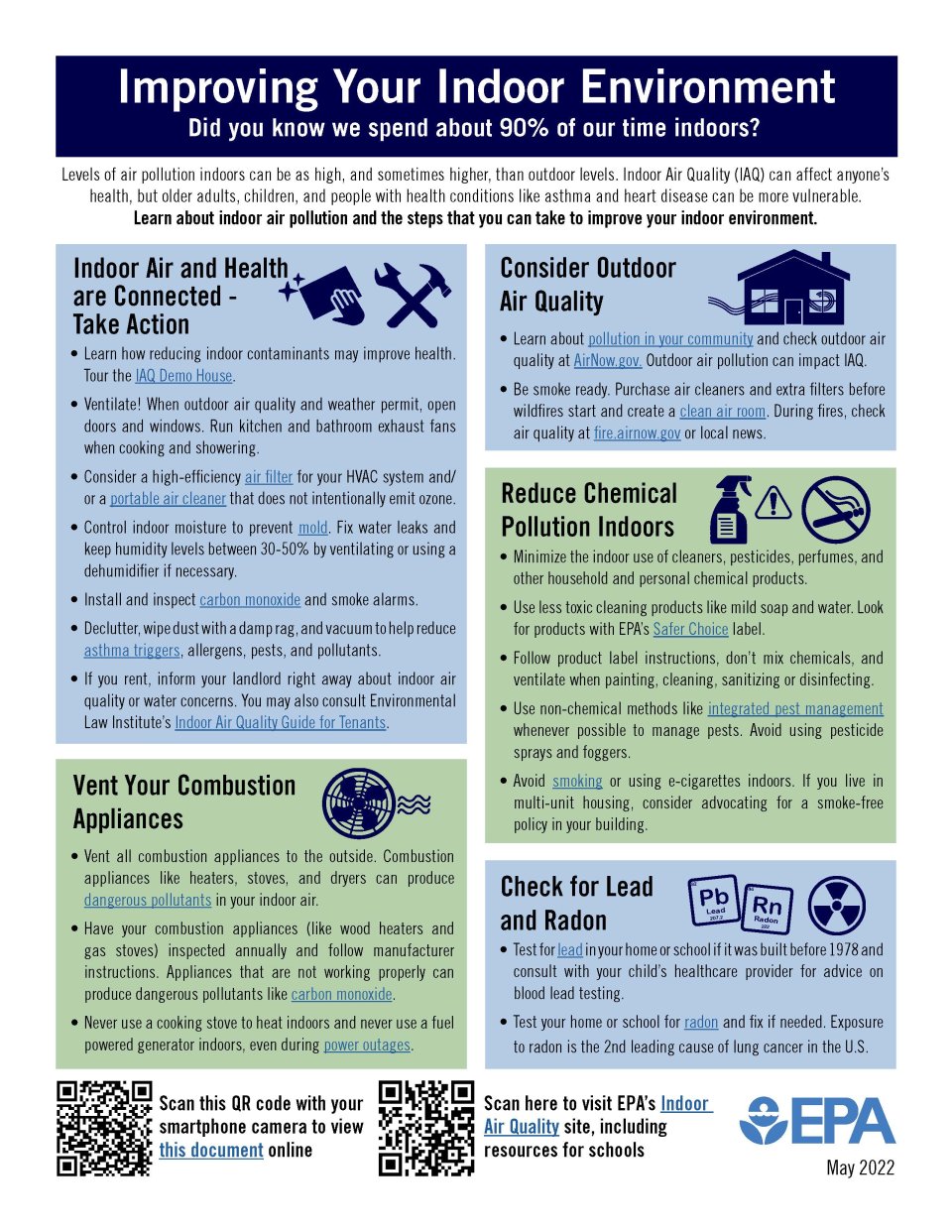
Improving Your Indoor Environment
This downloadable and printable PDF resource provides information about the most common types of IAQ concerns, and the steps you can take to address them.
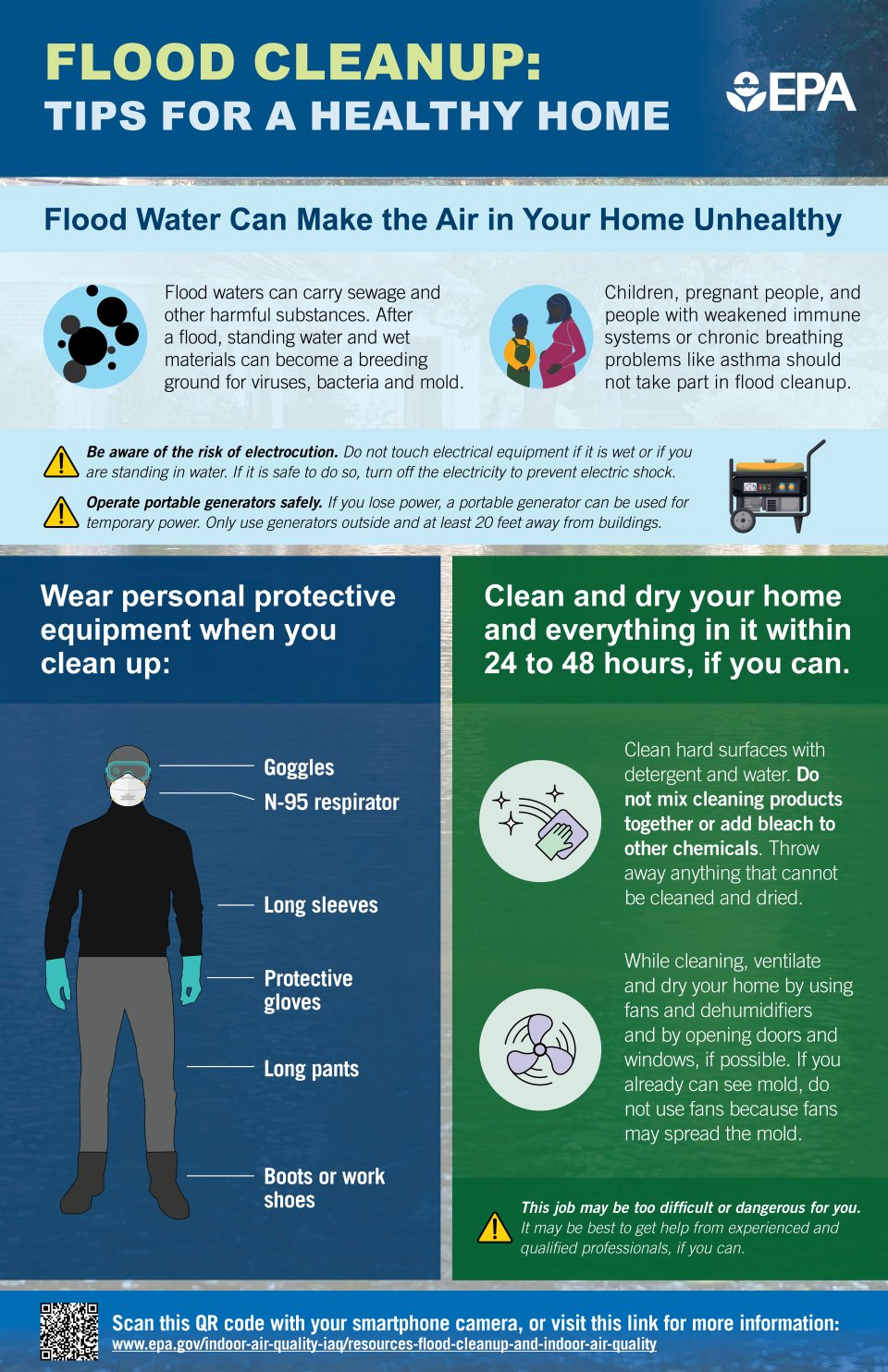
This downloadable and printable PDF resource provides information on how to clean up after a flood and how to prevent indoor air problems with helpful illustrations.
This infographic is available as a:
Flood Cleanup Infographic Color (pdf) and Flood Cleanup Infographic Grayscale (pdf)
It is also available in several languages as a color version and grayscale version.
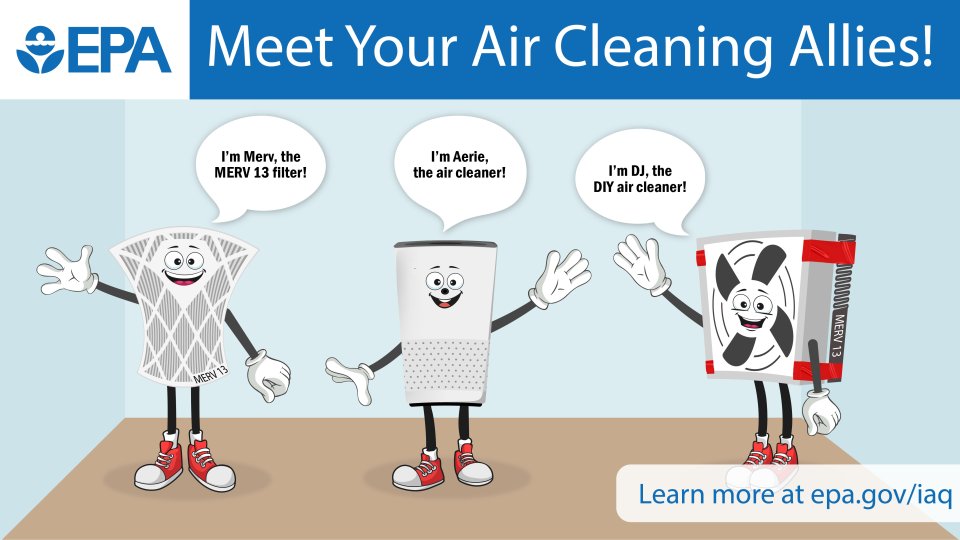

Indoor Air Quality-Related Fact Sheets
- Safety Tips for Using Foggers and Misters Indoors
- Protect Your Family and Yourself from Carbon Monoxide Poisoning
- Factsheet: Flood Cleanup - Protecting Indoor Air Quality
- Ozone Generators that are Sold as Air Cleaners
- Sick Building Syndrome
- Use and Care of Home Humidifiers
- Ventilation and Air Quality in Offices
Safety Tips for Using Foggers and Misters Indoors
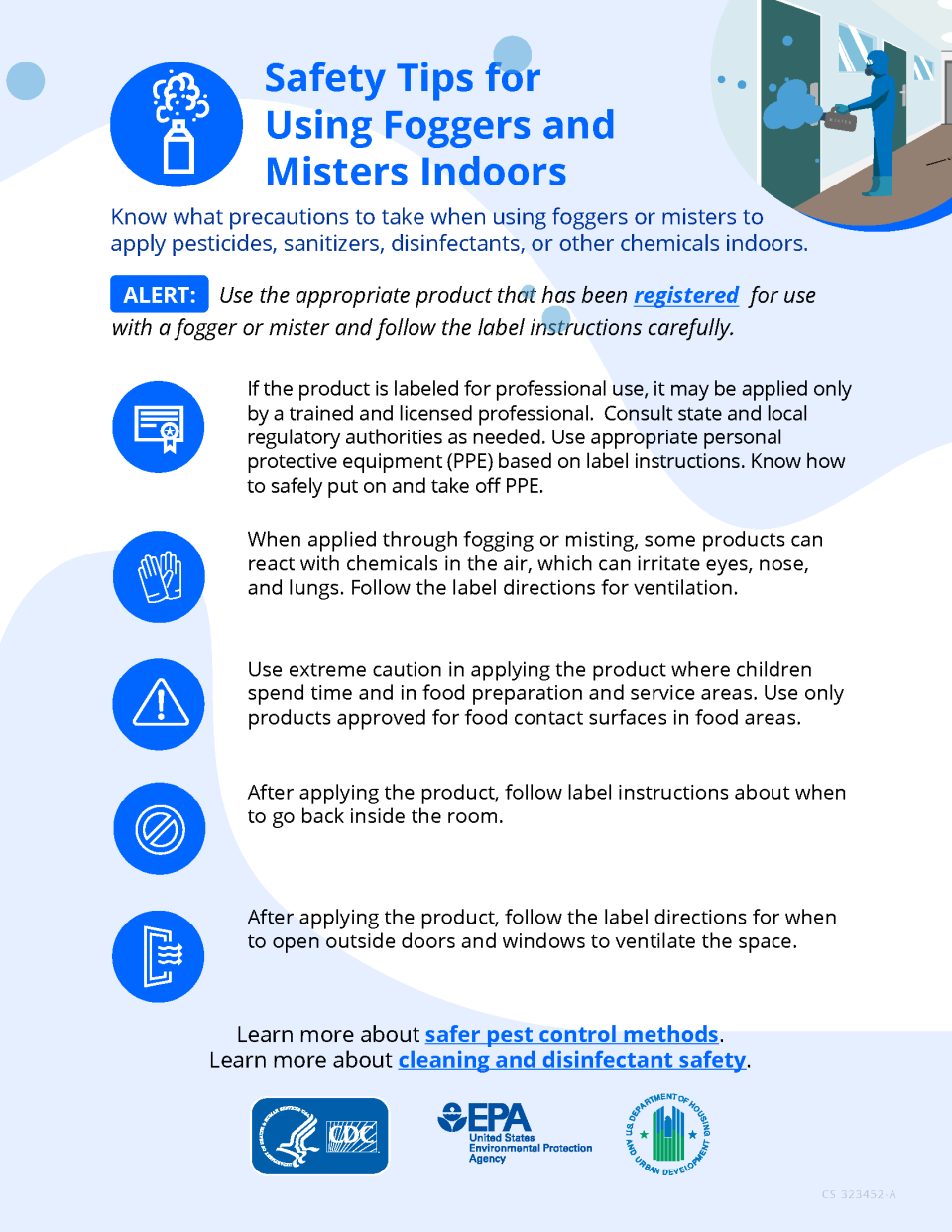
Know what precautions to take when using foggers or misters to apply pesticides, sanitizers, disinfectants, or other chemicals indoors.
Protect Your Family and Yourself from Carbon Monoxide Poisoning
You can’t see or smell carbon monoxide, but at high levels it can kill a person in minutes. Carbon monoxide (CO) is produced whenever any the following fuels are burned:
- gas
- oil
- kerosene
- wood
- charcoal
If appliances that burn fuel are maintained and used properly, the amount of CO produced is usually not hazardous. However, if appliances are not working properly or are used incorrectly, dangerous levels of CO can result. Hundreds of people die accidentally every year from CO poisoning caused by malfunctioning or improperly used fuel-burning appliances. Even more die from CO produced by idling cars. Fetuses, infants, elderly people and people with anemia or with a history of heart or respiratory disease can be especially susceptible. Be safe. Practice the DO’s and DON’Ts of carbon monoxide. This document is only available on-line.
The Carbon Monoxide fact sheet has also been translated into Vietnamese, Chinese and Korean.
Fact Sheet: Flood Cleanup - Protecting Indoor Air Quality
This fact sheet contains basic information on flood cleanup with illustrations and links to more detailed information
Fact Sheet: Flood Cleanup - Protecting Indoor Air Quality (pdf)
Ozone Generators that are Sold as Air Cleaners
Written for general audiences, this fact sheet provides accurate information regarding the use of ozone-generating devices in indoor occupied spaces. This information is based on the most credible scientific evidence currently available. Whether in its pure form or mixed with other chemicals, ozone can be harmful to health. Available scientific evidence shows that, at concentrations that do not exceed public health standards, ozone is generally ineffective in controlling indoor air pollution. The public is advised to use proven methods proven to be both safe and effective to reduce pollutant concentrations, which include controlling pollutant sources and increasing outdoor air ventilation. This document is only available on-line.
- Ozone Generators that are Sold as Air Cleaners
- Ozone Generators that are Sold as Air Cleaners: An Assessment of Effectiveness and Health Consequences (pdf)
Sick Building Syndrome - Indoor Air Facts No. 4 (revised)
Explains the terms "sick building syndrome" (SBS) and "building related illness" (BRI). Discusses causes of sick building syndrome, describes building investigation procedures and provides general solutions for resolving the syndrome. This document is only available on-line.
Use and Care of Home Humidifiers
Explains that some types of home humidifiers can disperse microorganisms from their water tanks into the indoor air. Describes the different types of humidifiers and provides recommendations for their use and maintenance. This document is only available on-line.
Ventilation and Air Quality in Offices
Discusses the role of mechanical heating, ventilation and air conditioning systems in maintaining indoor air quality of commercial buildings such as offices, stores, and hotels. Topics include health problems associated with poor ventilation, ways of controlling pollution, ventilation standards and building codes, and various ventilation system problems and solutions. Provides measures for resolving air quality problems and sources for additional information. This document is only available on-line.
Tools, Models and Studies
Energy Cost and IAQ Performance of Ventilation Systems and Controls Modeling Study

In 1999, EPA completed an extensive modeling study to assess the compatibilities and trade-offs between energy, indoor air quality, and thermal comfort objectives for HVAC systems, and to help formulate strategies to simultaneously achieve superior performance on each objective. Variations of Constant Volume (CV) and Variable Air Volume (VAV) HVAC systems were modeled in three different climates-hot and humid (Miami), temperate (Washington D.C.) and cold (Minneapolis). Buildings included several variations of an office building, plus a school and an auditorium.
Project Reports and Summaries
Contractor Report: Flood-Related Cleaning
- EPA’s Indoor Environments Division commissioned a report that addresses approaches to cleaning up residences flooded after a hurricane or other weather event. This report is based on a literature search. The report considers the types of illnesses associated with such flooding; the effectiveness, selection, use and hazards of biocides for cleaning and decontaminating surfaces affected by the presence of microorganisms and their biofilms; and available guidance documents that provide recommendations for cleaning up after floods, hurricanes and related events. This document is a technical summary of existing research and guidance on health hazards from floods, flood damage, and cleanup activities. While EPA’s Indoor Environments Division commissioned the report, it does not necessarily represent EPA policy. Authors: Terry Brennan (Camroden Associates), Gene Cole, Dr. P.H., and Brent Stephens, Ph.D. August 2018.
Contractor Report: Health, Energy Efficiency and Climate Change
- EPA's Indoor Environments Division commissioned a report that addresses the impacts of climate change on indoor environments. The report includes material related to potential interventions and solutions. Author: Terry Brennan. December 2010.
Contractor Report: Impact of Weather Events (pdf)
- EPA's Indoor Environments Division commissioned a report that addresses the impacts of severe weather events on indoor environments. The report includes material related to the use of buildings as shelters from weather extremes. Author: Terry Brennan. December 2010.
DRAFT Contractor Report: Opportunities for Green Building (GB) Rating Systems to Improve Indoor Air Quality Credits and to Address Changing Climatic Conditions
- EPA's Indoor Environments Division commissioned a report that addresses green building rating systems and indoor environments. The report includes material related to moisture, ventilation, thermal comfort and other issues. Author: Jelena Srebric, Ph.D. September 2010.
Contractor Report: National Programs to Assess Indoor Environmental Quality (IEQ) Effects of Building Materials and Products
- EPA’s Indoor Environments Division commissioned a report that addresses national product evaluation programs. The report includes material related to emissions testing and research issues. Author: Hal Levin, September 2010.
Contractor Report: Building Codes and Indoor Air Quality (IAQ) (PDF)
- EPA’s Indoor Environments Division commissioned a report that addresses building codes, IAQ and related issues The report includes material related to both commercial buildings and residential buildings. Author: David Mudarri, Ph.D., September 2010.
Contractor Report: Climate Change and Potential Effects on Microbial Air Quality (pdf)
- EPA’s Indoor Environments Division commissioned a report that addresses climate change impacts on microbes, indoor environments and related issues. Topics addressed in the report include Legionella and other geographically emerging pathogens, air-conditioning and climate change, outdoor air ventilation and climate change, and severe weather events and the built environment. Author: Philip R. Morey, Ph.D., CIH, September 2010.
Contractor Report: Climate Change, Indoor Air Quality and Health (pdf)
- EPA’s Indoor Environments Division commissioned a report that addresses climate change, indoor air quality and health. Topics addressed include green buildings, public health and consideration of the training needs of professional communities on buildings and health issues. Authors: Paula Schenck, MPH; A. Karim Ahmed, PhD; Ann Bracker, MPH, CIH; Robert DeBernardo, MD, MBA, MPH. University of Connecticut Health Center, August, 2010.
Contractor Report: Climate Change and Indoor Air Quality - Contractor Report (pdf)
- EPA’s Indoor Environments Division commissioned a report that addresses climate change and indoor air quality. Topics in the report include residential ventilation patterns, changes in the built environment, occupant behavior and radon. Author: R. William Field, Ph.D., MS, June 2010.
Contractor Report: Research Needed to Address the Impacts of Climate Change on Indoor Air Quality
- EPA’s Indoor Environments Division commissioned a report that addresses climate change and indoor air quality research needs. Topics addressed in the report include water/moisture intrusion and disease vectors. Author: John Girman, July 2010.
Contractor Report: Public Health Consequences and Cost of Climate Change Impacts on Indoor Environments
- EPA’s Indoor Environments Division commissioned a report that addresses climate change impacts on indoor environments. Buildings protect people from the elements and otherwise support human activity. Unless managed well, however, environmental conditions inside buildings have the potential to make people sick, cause them discomfort, or otherwise inhibit their ability to perform. This report presents a preliminary analysis of the changes in indoor environmental quality likely to result from changes in climate and to assesses the potential public health consequences of those changes. This report also provides a preliminary analysis of the economic cost of these public health consequences. Author: David Mudarri, Ph.D., January 2010.
Contractor Report: Criteria for Evaluating Programs that Assess Materials/Products to Determine Impacts on Indoor Air Quality (pdf)
- EPA’s Indoor Environments Division commissioned the following report under contract with Bruce Tichenor to gain a better understanding of private-sector, commercial programs which currently provide labels or certifications to products and materials used indoors. Because it is a contractor’s report, it presents the findings, recommendations and views of its author, and not necessarily those of EPA, regarding emissions from indoor sources. However, since the report contains so much valuable and timely information, EPA chooses to release this contractor’s report in its current form in the belief that other organizations, e.g., industry associations, standard-setting organizations and government agencies, will benefit from the information it offers. EPA believes it will stimulate constructive discussion and promote further progress in this important area. March 17, 2006. Read the report (includes a forward by the Indoor Environments Division)
Program Needs for Indoor Environments Research (PNIER) (pdf)
- PNIER is a strategic document intended to capture the indoor environments research needs of all EPA offices with program responsibilities related to indoor environmental quality, and was developed with strong collaboration across several EPA offices. The needs are extensive and range from basic research on sources and emissions (including biological, chemical and particulate matter), through exposure characterization, health effects and mitigation techniques. It is anticipated that PNIER will articulate EPA’s indoor environments research needs, for both internal and external uses; identify where knowledge gaps exist; help establish a more well-defined indoor environments research presence at EPA; facilitate collaboration between EPA’s program offices and research laboratories; and possibly serve as EPA’s foundation towards a larger federal cross-agency research strategy on indoor environments research.
- EPA 402-B-05-001, March 2005
ASHRAE Indoor Air Quality IAQ Design Guide
- The American Society of Heating, Refrigerating and Air Conditioning Engineers (ASHRAE) is now making the IAQ design guide and all of its reference materials available to the public at no cost through its website. The Indoor Air Quality Guide: Best Practices for Design, Construction and Commissioning is designed for architects, design engineers, contractors, commissioning agents and all other professionals concerned with indoor air quality.
Project Summary: The Total Exposure Assessment Methodology (TEAM) Study
- Summarizes a study of exposure to toxic and carcinogenic chemicals (VOCs) in the air and drinking water by 600 residents of seven U.S. cities. Study concluded that indoor air in the home and at work far outweighs outdoor air as a route of exposure to toxic chemicals. Other major findings: Study demonstrated the utility of breath sampling to estimate levels of toxic chemicals in the body due to normal daily exposure; also demonstrated utility of TEAM approach for estimating exposure of entire urban populations and gaining an understanding of the sources of exposure. Summary includes a listing of TEAM study published articles and reports. U.S. EPA, Office of Acid Deposition, Environmental Monitoring and Quality Assurance, Office of Research and Development, [EPA 600/S6-87/002, September 1987]
Project Summary: Indoor Air Quality in Public Buildings: Volume I
- Summarizes a study of VOCs present in new and existing buildings. The researchers identified 500 VOCs in indoor air in four buildings (a school, two homes for the elderly, and an office building) and determined that concentrations of certain target VOCs are elevated in buildings due to emissions from certain building materials (measurements were taken from 16 such materials). Concentrations of compounds such as xylene and decane were elevated in the new building at completion of construction but fell off markedly within six months. Study was limited in scope and duration, made no extrapolations or estimates of VOC distribution frequency in public buildings, and recommended further study involving different types of buildings and many more types of building materials. A copy of the study report may be obtained from the National Technical Information Service in Springfield, Virginia. U.S. EPA. [EPA 600/S6-88/009a, September 1988]
Project Summary: Indoor Air Quality in Public Buildings: Volume II
- Summarizes results of companion study to that reported by Volume I. Six buildings were sampled for VOCs (a hospital, two homes for the elderly, two office buildings and an institute for governmental studies). The new buildings had high concentrations of aromatic and aliphatic hydrocarbons immediately after completion but concentrations declined by an order of magnitude within several months. Building materials emitting these chemicals at the highest rates were surface coatings such as adhesives, caulking and paints; wall and floor coverings such as molding, linoleum tile and carpeting; and miscellaneous other materials such as vinyl telephone cables. Researchers surmised that renovation or refurbishment of buildings would also result in temporarily higher concentrations of these chemicals. A copy of the study report may be obtained from the National Technical Information Service in Springfield, Virginia. U.S. EPA. [EPA 600/S6-88/009b, September 1988]
Project Summary: Compendium of Methods for the Determination of Air Pollutants in Indoor Air
- Summarizes research project which developed a Compendium of Methods for the Determination of Air Pollutants in Indoor Air. The Compendium provides regional, state and local environmental regulatory agencies with standardized, step-by-step sampling and laboratory analysis procedures for the determination of selected pollutants in indoor air. A core set of ten chapters, with each chapter containing one or more methods, covers VOCs, carbon monoxide and carbon dioxide, air exchange rate, benzo(a)pyrene and other polynuclear aromatic hydrocarbons, and several other contaminants. A copy of the full document may be obtained from the National Technical Information Service in Springfield, Virginia, U.S. EPA. [EPA 600/S4-90-010, May 1990]
Introduction to Indoor Air Quality: A Self-Paced Learning Module
- The Indoor Air Quality Learning Module and its companion document, the Indoor Air Quality Reference Manual, provide an introduction to indoor air quality for environmental health professionals. Primary focus is on residential indoor air quality. Documents cover those aspects of indoor air quality important for establishing an indoor air quality program by a state or local government agency. Developed under a cooperative arrangement between the National Environmental Health Association, the Bureau of Health Professions of the U.S. Public Health Service and the EPA. [EPA 400-39-1002, July 1991]
Introduction to Indoor Air Quality: A Reference Manual
- The Indoor Air Quality Reference Manual is the companion document to the Indoor Air Quality Learning Module. The Reference Manual provides an opportunity for continuing education plus useful reference material on selected indoor air quality topics. Divided into eight sections corresponding to the first eight lessons of the Learning Module, the Reference Manual also contains information and exhibits which can be used in field investigations (e.g., problem diagnosis, sample measurement, data collection forms and a listing of public health and occupational standards).
Developed under a cooperative arrangement between the National Environmental Health Association, the Bureau of Health Professions of the U.S. Public Health Service and the EPA. [EPA 4003-91-003, July 1991] Note: This set of documents may be obtained for $47 by nonmembers and $40 by members (plus $7.50 for shipping & handling).- Contact the National Environmental Health Association
"Building Air Quality Training Kit" with instructor materials and handouts to conduct a 4-hour companion course ($150.00) to Building Air Quality: A Guide for Building Owners and Facility Managers.
"Orientation to Indoor Air Quality" instructor and student materials used to conduct a 21/2 day training course ($180.00).
Pollutant Specific Publications
Wildfire Smoke

Why is Coco Red?
Coco and his friends experience an air quality adventure. Read how Coco, his little sister and his friends solve a mystery as they learn about how wildfires can affect air quality and health. This book is for all children, especially those with asthma, and their caretakers.
Healthy Indoor Painting Practices CPSC Publication #465
- This safety guide was formulated for residents, property managers and painters who are strongly urged to follow several simple steps to reduce possible adverse reactions to chemicals emitted from paints. The publication was produced by EPA's Office of Pollution Prevention and Toxics (OPPT) and the Consumer Product Safety Commission (CPSC), in cooperation with the Montgomery County, Maryland Department of Environmental Protection.
- Healthy Indoor Painting Practices (pdf) (2 pp, 12O KB)
World Health Organization (WHO) guidelines for indoor air quality: selected pollutants
Smoke-free Homes

Secondhand Tobacco Smoke and the Health of Your Family Brochure (Bilingual) EPA 402/F/09-004, September 2009
With English text on one side and Spanish text on the other side, this straightforward brochure explains the basics about the dangers of secondhand smoke to families, especially to children. This tri-fold brochure (available here for download as PDF file) could be used at health fairs, clinics and hospitals, parent meetings and at other community activities.
Related IAQ Publications Available from the Consumer Product Safety Commission (CPSC)
Consumer Product Safety Commission's Safety Education Resources
Asbestos in Your Home CPSC Publication #453
This document discusses health effects of asbestos exposure, identifies common products and building materials from the past that might contain asbestos, and describes conditions which may cause release of asbestos fibers. Describes how to identify materials that contain asbestos and how to control an asbestos problem. Explains role of asbestos professionals and use of asbestos inspectors and removal contractors. This brochure was prepared by the American Lung Association, the U.S. Consumer Product Safety Commission and the EPA.
Biological Pollutants in Your Home CPSC Publication #425
This document explains indoor biological pollution, health effects of biological pollutants and how to control their growth and buildup. One third to one half of all structures have damp conditions that may encourage development of pollutants such as molds and bacteria, which can cause allergic reactions--including asthma--and spread infectious diseases. Describes corrective measures for achieving moisture control and cleanliness. This brochure was prepared by the American Lung Association and the U.S. Consumer Product Safety Commission.
An Update on Formaldehyde 2016 Revision CPSC Publication #725
The U.S. Consumer Product Safety Commission, with assistance of EPA, developed this brochure to provide information about formaldehyde in indoor air. The brochure tells consumers where they may come in contact with formaldehyde, how it may affect their health and how their exposure to formaldehyde might be reduced. The publication was updated by CPSC in 2016.
- An Update on Formaldehyde 2016 Revision (pdf) (12 pp, 607 KB)
The "Invisible" Killer
Describes symptoms of carbon monoxide poisoning, sources of carbon monoxide in the home and actions that can reduce the risk of carbon monoxide poisoning. This leaflet was prepared by the U.S. Consumer Product Safety Commission.
What You Should Know About Using Paint Strippers CPSC Publication #F-747-F-95-002, 1995
Paint strippers contain chemicals that loosen paint from surfaces. These chemicals can harm you if not used properly. Some paint stripping chemicals can irritate the skin and eyes, or cause headaches, drowsiness, nausea, dizziness, or loss of coordination. Some may cause cancer, reproductive problems, or damage of the liver, kidney, or brain. Others catch fire easily. Proper handling and use of paint strippers will reduce your exposure to these chemicals and lessen your health risk. This brochure was prepared with EPA and the U. S. Consumer Product Safety Commission.

